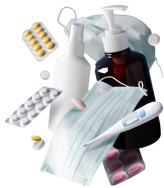-
Description
This drug contains Escitalopram; a potent selective serotonin reuptake inhibitor (SSRI), 5-HT (5-hydroxytryptamine, serotonin) transporter (SERT) mediates the reuptake of 5-HT from the synaptic cleft into the neuron, and inhibition of this uptake is the target of selective serotonin reuptake inhibitors (SSRIs) like Escitalopram. Escitalopram is an active isomer of citalopram, binds to the sodium-dependent serotonin transporter protein (SERT) located in the presynaptic neuron. SERT reuptakes serotonin from the synaptic cleft to the presynaptic neuron. Escitalopram Inactivates SERT, as a result amount of serotonin is increased in the synaptic cleft. Serotonin or 5-hydroxytryptamine (5-HT) are involved in modulating a wide range of human behavioral processes, including mood, perception, memory, appetite, fear, anger, aggression, stress response, addiction, and sexuality. So by establishing normal levels of 5-HT; escitalopram treats; major depressive disorder (MDD), generalized anxiety disorder (GAD), and other psychiatric disorders such as obsessive-compulsive disorder. It has superior efficacy and faster onset compared to other SSRIs.
-
Ingredients
Escitalopram
-
Drug Class
Selective serotonin reuptake inhibitor (SSRI)
-
Dosage Form
Tablet
-
Uses
Depression, General Anxiety, Panic & Social Disorder, and Major Depressive Disorder, Obsessive-Compulsive Disorder, Prevention of Depression relapses.
-
Dosage
Dose must be taken according to the doctor’s advice only; doses given below are suggested as supportive literature for better understanding in some areas of requirements. Adult dose: For generalized anxiety disorders; Initial dose: 10mg orally one time a day; increase if necessary after at least 1 week of treatment to 20mg one time a day. Maintenance dose: 10 to 20mg orally one time a day. Maximum dose: 20mg orally one time a day. For depression: Initial dose: 10mg orally one time a day; increase if necessary after at least 1 week of treatment to 20mg one time a day. Maintenance dose: 10 to 20mg orally one time a day. Maximum dose: 20mg orally one time a day. Geriatric (65 years above) dose: For Depression; 10mg orally one time a day. Pediatric Dose: For depression; Initial dose: 10mg orally one time a day; increase if necessary after at least 3 weeks of treatment to 20mg one time a day. Maintenance dose: 10 to 20mg orally one time a day. Maximum dose: 20mg orally one time a day.
-
In case of Overdose
Use of Escitalopram in high doses of up to 600 mg has been found to be associated with reversible symptoms like dizziness, sweating, nausea, vomiting, tremor, and somnolence. Rarely confusion, loss of consciousness, convulsions, coma, sinus tachycardia, cyanosis, hyperventilation and rhabdomyolysis might occur. In such cases following measures should be taken: airway maintenance, gastric lavage, use of activated charcoal, cardiac and vital sign monitoring and general symptomatic and supportive measures. There is no specific antidote for Escitalopram.
-
Missed Dose
In case you missed any dose, take the next dose as soon as you remember, but don't double your next dose to compensate for the missed one.
-
How To Use
Escitalopram can be taken with or without food. Swallow the tablet with water. Do not chew them.
-
When Not to Use
It is contraindicated in patients with known hypersensitivity to Escitalopram oxalate, citalopram or any ingredient of the product.
-
Side Effects
The side effects reported are; Agitation Restlessness Blurred vision Diarrhea Difficulty in sleeping Drowsiness Dry mouth Fever Difficulties urinating Headache indigestion Nausea Increased or decreased appetite Increased sweating Sexual difficulties like decreased sexual ability or libido & ejaculatory delay Change in taste Tremor Weight changes
-
Precautions & Warnings
Use in Patients with History of Seizure: Like other antidepressants, Escitalopram should be cautiously used in patients with a history of seizure disorder.
-
Drug Interactions
The drug interactions with escitalopram include:
- MAO Inhibitors – Concurrent use with monoamine oxidase inhibitors (MAOIs) can lead to serotonin syndrome, a potentially life-threatening condition.
- Other Antidepressants – Combining with other antidepressants, especially SSRIs or SNRIs, can increase the risk of serotonin syndrome.
- Anticoagulants and Antiplatelet Agents – Escitalopram can increase the risk of bleeding when used with anticoagulants or antiplatelet drugs such as warfarin or aspirin.
- NSAIDs – Non-steroidal anti-inflammatory drugs (NSAIDs) may increase the risk of gastrointestinal bleeding when used with escitalopram.
- CYP3A4 Inhibitors – Escitalopram metabolism can be affected by CYP3A4 inhibitors like ketoconazole, leading to increased escitalopram levels and potential side effects.
- CYP2C19 Inhibitors – Inhibitors of CYP2C19, such as omeprazole, can increase escitalopram levels, potentially leading to an increased risk of side effects.
- Lithium – Combining escitalopram with lithium may increase the risk of serotonin syndrome and require careful monitoring.
- Alcohol – Escitalopram can enhance the sedative effects of alcohol, leading to increased drowsiness and impaired coordination.
- St. John's Wort – This herbal supplement can interact with escitalopram, potentially leading to serotonin syndrome and reducing the effectiveness of escitalopram.
- Tramadol – The combination with tramadol can increase the risk of serotonin syndrome and requires careful monitoring.
-
Food Interactions
Grapefruit juice could contribute towards unwanted effects.
-
Storage/Disposal
Store below 25°C, at a dry place.
-
Laboratory Screening
To monitor organs performance before and with the use of this drug, go for the following tests: For brain; CT-scan.

